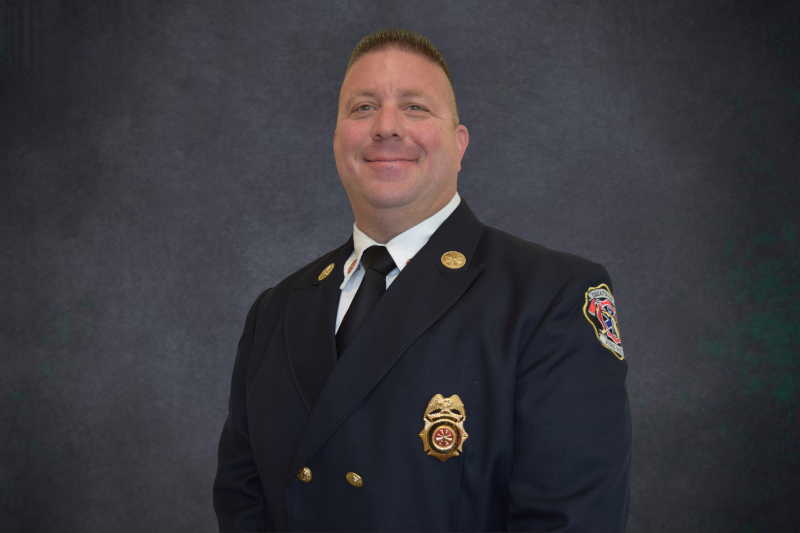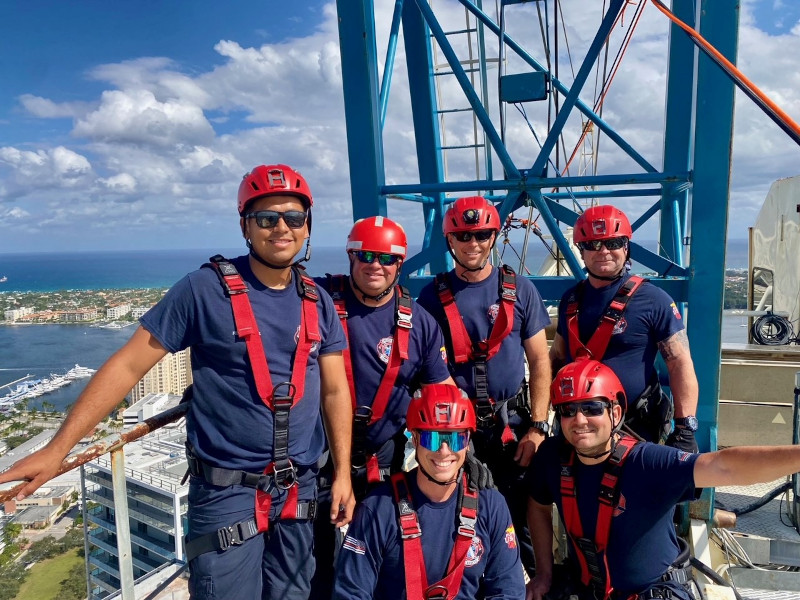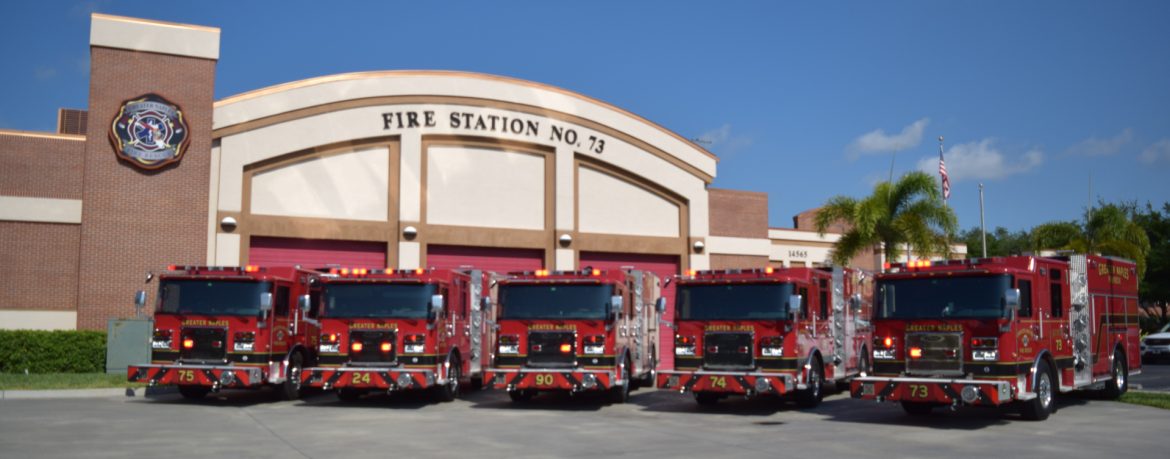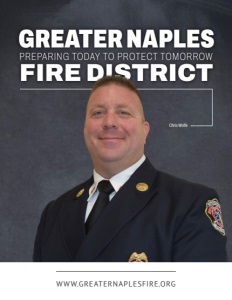Greater Naples Fire District
Preparing Today to Protect Tomorrow
Tackling workforce challenges, advancing infrastructure, and adapting to new threats to safeguard Collier County.
Covering an impressive 1,512 square miles, the Greater Naples Fire District commands the lion’s share of Collier County in southwest Florida. With responsibility for over half of the county’s landmass, it’s one of the largest fire districts in the state, both geographically and operationally. Tasked with fire suppression, emergency medical services (EMS), and specialized rescue operations, the district handles many services and responsibilities far beyond the typical fire department.
“Our apparatus are staffed daily with paramedics who deliver the same level of care as Collier County EMS,” says Fire Chief Chris Wolfe. While Collier County EMS handles patient transport, he explains that Greater Naples Fire provides advanced life support on the scene, ensuring medical care begins immediately. “It’s not just about putting out fires; it’s about saving lives in all forms.”
Wolfe paints a picture of a fire district that’s much more than hoses and firetrucks. “We manage a Florida State technical rescue team, and our hazmat technicians are equipped to handle a range of emergencies,” he says. The technical rescue team, he adds, is prepared for complex scenarios such as collapsed structures or high-angle rescues. “We’re not only ready for the routine—we’re ready for the unthinkable.”

Chris Wolfe, Fire Chief
Collaboration and Community at the Core
The Greater Naples Fire District thrives on the philosophy that public safety is a shared responsibility. Wolfe explains that the relationship between the fire department and the community is symbiotic. “The community invests in us through their tax base,” he says, “and in return, we serve them. It’s a cycle that promotes public safety in every sense.” Beyond service delivery, the district actively engages with the people it protects, creating meaningful connections that extend well beyond emergencies.
“We’re heavily involved in community outreach,” Wolfe continues, describing the department’s educational programs. Firefighters regularly visit local elementary and preschools, offering demonstrations with fire trucks and equipment. “In the summer, we run campaigns like spray-downs, where we use the big nozzles to cool kids off during camps or school programs. It’s one of those things that sticks with them and makes fire safety approachable.” Seasonal events like “trunk or treat” during Halloween and year-round smoke detector awareness programs are staples of the district’s outreach efforts.
Wolfe then emphasizes the daily coordination among the county’s five fire districts, including unincorporated Collier County and Collier County EMS. He highlights the district’s growing partnership with the Collier County Sheriff’s Office as an example of how interagency collaboration enhances operations. “The sheriff’s aviation helicopters are now equipped with firefighting tools, like Bambi buckets,” he explains, referring to the specialized equipment used to drop water over wildfires.
The district also mobilizes neighborhood-based Community Emergency Response Teams (CERT) to bridge the gap between professional responders and the public. “These groups are trained to handle low-level but critical tasks,” Wolfe explains. “They help us canvass neighborhoods during a search for a missing person or distribute information after a disaster. It’s organized, proactive, and invaluable in emergencies.”
Facing the Challenges of Natural Disasters
Emergency preparedness for extreme weather and other disasters is a priority for the Greater Naples Fire District and a discipline they’ve refined over years of experience. Wolfe’s leadership shows a pragmatic approach to disaster response, particularly when it comes to hurricanes. “A hurricane is not an unplanned event,” he explains. “We know it’s coming. The only question is how much we’ll be impacted.” With advance notice, the district can execute staffing plans, secure facilities, and prepare equipment, creating a structured response for a severe storm that is otherwise unpredictable.
That predictability, however, only goes so far. Wolfe highlights that hurricanes are no longer just about destructive winds; rising water and storm surges are becoming the most dangerous and uncertain factors. “We’ve had to pivot our response strategy significantly,” he says. “High-water vehicles, boats, and even foot evacuations are now essential tools as we assess conditions and decide how to get people out safely.”
Not all disasters come with a warning, however. Tornadoes or building collapses demand immediate action from the district’s day-to-day staffing. Wolfe points out that these unpredictable scenarios can strain resources, particularly when dramatic images on TV shape public expectations of emergency services. “The community expects us to handle disasters at the scale they see elsewhere,” he notes, “and we’ve been fortunate to have a strong tax base that allows us to meet many of those expectations.” Recent increases in that funding have enabled the district to strengthen its response capabilities.
Contending with Emerging Threats
Beyond natural disasters, new challenges are emerging with the rapid adoption of electric vehicles (EVs) and other lithium-ion battery-powered devices. “Lithium-ion batteries are a major emerging threat,” Wolfe warns. “The problem isn’t just confined to vehicles. We’re seeing fires from electric scooters, bikes, and even skateboards. The rapid evolution of these technologies means recommendations and best practices are constantly changing.” Adding to the complexity, Wolfe highlights issues related to charging infrastructure, particularly in high-rises and parking garages. “There’s a lot of discussion happening about fire codes and whether additional fire protection systems are needed in these spaces to prevent further damage from EV fires.”
While some fire agencies in metropolitan areas are beginning to adopt electric-powered fire trucks, Wolfe believes that geography and logistics make this impractical for Greater Naples. “We cover an area larger than Rhode Island,” he explains. “Battery-powered apparatus might make sense in a city with short distances, but not here.” However, he acknowledges that smaller renewable energy vehicles may have a role to play in the district’s future. “There’s potential for integrating renewable energy at a smaller scale,” he says, “but it’s not something that fits easily into an operation of this size.”
A Push for Capital Infrastructure
In the world of public safety, infrastructure encompasses physical buildings and equipment and maintaining the ability to respond effectively today while preparing for the challenges of tomorrow. Wolfe explains that the Greater Naples Fire District is addressing a long-standing issue: more consistent investment in capital repair and replacement. “It’s a three-pronged approach,” he says. “First, we’re tackling the gaps from the past. Second, we’re meeting today’s needs. And third, we’re planning to ensure we don’t repeat the mistakes we’ve made before.”
This forward-looking strategy has been made possible through significant community support. In August, voters approved a 0.5 millage increase—additional tax revenue dedicated solely to capital infrastructure. “Our community stepped up for us, unwavering,” Wolfe says. Now, it’s on us to deliver. Starting next fall, we’ll begin addressing key projects that have been on hold for too long.”
However, Wolfe acknowledges that moving these projects forward is far from simple. Supply chain challenges remain a significant hurdle. “In years past, if we ordered a fire truck now, we’d typically have it in nine to twelve months,” he explains. “Today, even with some improvement, we’re looking at 30 to 48 months for delivery.”
Fire station construction poses another challenge. Costs have soared, with stations now priced at $900 to $1,300 per square foot to build. Despite funding, progress is slowed by lengthy permitting processes, contractor shortages, and the ongoing labor gap across the construction industry. “It’s not just public safety,” Wolfe points out. “It’s a global workforce issue. Finding contractors willing and able to take on these projects is a battle of its own.”
Despite these obstacles, Wolfe remains focused on the mission at hand. “We have to move the needle,” he says. “The community supported us, and we need to honor that trust by meeting their expectations.”

Bridging Workforce Gaps and Supporting Firefighters
Recruitment and retention in the fire service are more challenging now than ever, Wolfe admits. The available workforce has thinned dramatically, creating a staffing shortage that has become a statewide concern. “The workforce in our field is very lean right now,” he says. “We’ve seen white papers from the Florida Association of Fire Chiefs outlining the problem. Staffing gaps, retirements, lack of loyalty, and shifting priorities among younger generations are all contributing factors.”
Greater Naples Fire District is actively addressing this crisis, particularly through outreach and partnerships. “We’ve been participating in career days and working with a local university on an internship program,” Wolfe explains. “Some surrounding departments run teen firefighter programs, which get young people in the firehouse,” he adds. “They put on the gear, run water through a hose, and experience the job—without fully doing it. It’s a great hands-on introduction.”
Despite these efforts, Wolfe acknowledges that the district is still playing catch-up. “I estimate we’re about 40 firefighters short,” he says, a consequence of past economic downturns and administrative decisions. While hiring efforts are underway, there are constraints on how many recruits the district can onboard at one time. “Our capacity to train new hires through our onboarding academy and their probationary year really drives how many we can bring in at once,” he explains. “We want to set new hires up for long-term success, not just filling vacancies.”
Equally critical is the well-being of current personnel. The district is beginning to formalize its approach to mental health. “The topic of mental health has shifted dramatically in our field,” he notes. “It used to be ‘suck it up and keep moving.’ Now, it’s a much more open and necessary conversation.” Wolfe emphasizes that healthy firefighters are better equipped to serve the community, and addressing mental health is foundational to their core mission.
The district is building its program thoughtfully. “We’ve identified about half a dozen people to lead this effort,” Wolfe shares, adding that flexibility is key. “There isn’t a one-size-fits-all solution for mental health. Early in my career, the Employee Assistance Program was the go-to, but now we recognize every situation is unique.” Whether it’s a work-related crisis or a personal issue, he insists on tailoring resources to the individual’s needs. “Pairing the right support with the situation is how we make sure our team—both certified and non-certified staff—gets the help they need to keep going.”
Into the Future: Leadership, Growth, and Expansion
Looking ahead, the Greater Naples Fire District is entering a period of profound transformation. A top priority, Wolfe says, is mentoring and preparing the next generation of leaders. “Our bench is lean,” he admits. “Many of us, including much of the executive team, are nearing retirement, and there’s a real gap when it comes to developing the next wave of leadership.” He points to multiple factors contributing to this challenge, from lingering disengagement among personnel to a need for more educational preparedness. “Career development is absolutely critical,” he says.
Workforce development is also about filling immediate needs. Wolfe estimates at least 20 new firefighters will be required to staff two additional fire stations, both of which are in the planning stages now. “We’re identifying response gaps in our coverage area,” he says, noting that construction on these stations is expected to break ground by fall 2026. “But before the stations open, we need to have personnel trained, prepared, and ready to step into rank positions.” It’s a process that requires meticulous planning to align hiring, training, and operational timelines.
Building on this ambitious agenda that spans leadership development, workforce expansion, capital projects, and operational enhancements, Wolfe is steering the Greater Naples Fire District through a critical juncture. Every step forward will meet today’s demands while ensuring the district is equipped to face future challenges.
AT A GLANCE
Greater Naples Fire District
What: One of Florida’s largest fire districts, providing fire rescue, EMS, and disaster response services
Where: Collier County, Florida
Website: https://www.greaternaplesfire.org/



